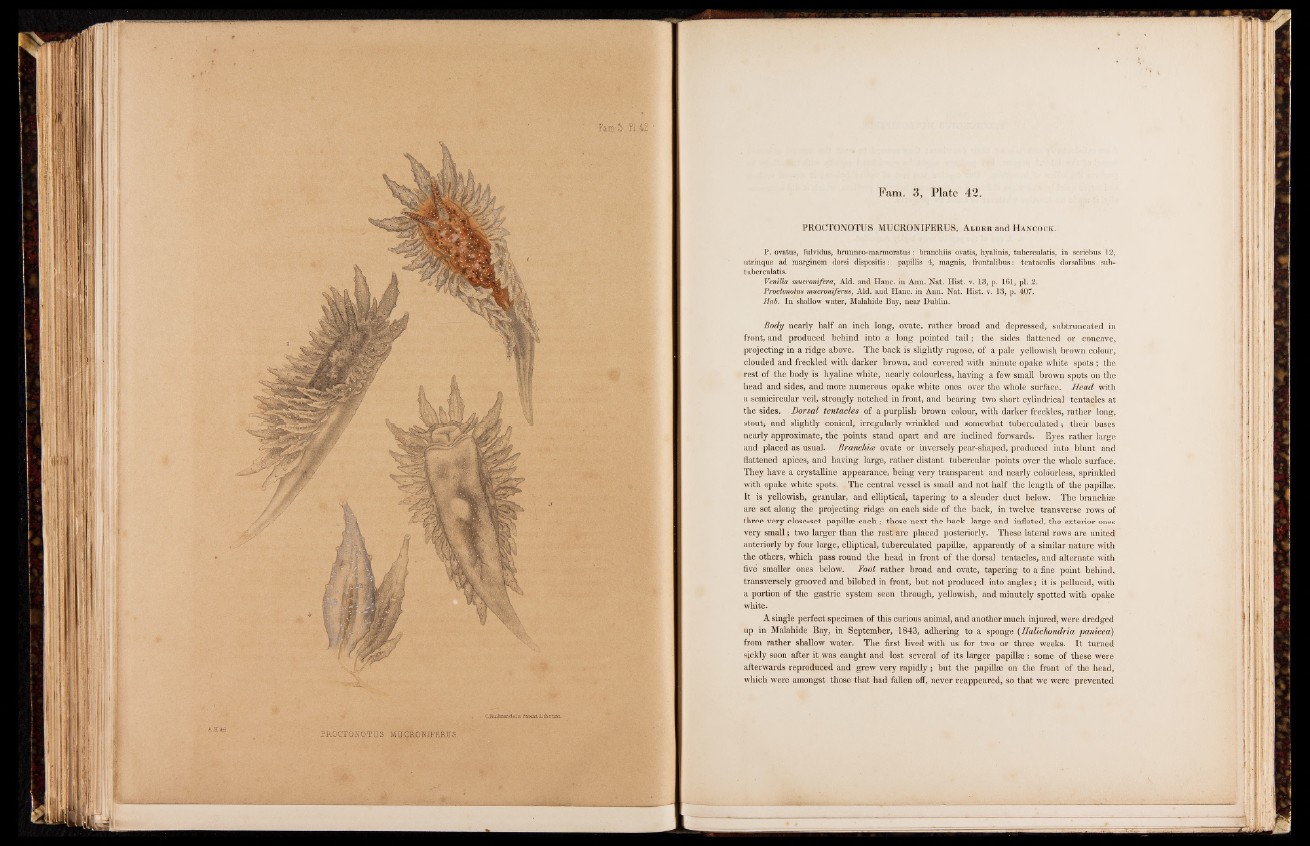
PROCTONOTUS MUCRONIFERUS, Alder and Hancock.
P. ovatus, fulvidus, brunneo-marmoratus: branchiis ovatis, hyalinis, tuberculatis, in seriebus 12,
utrinque ad marginem dorsi dispositis: papillis 4, magnis, frontalibus: tentaculis dorsalibus sub-
tuberculatis.
Venilia mucronifera, Aid. and Hanc. in Ann. Nat. Hist. v. 13, p. 161, pi. 2.
Proctonotus mucroniferns, Aid. and Hanc. in Ann. Nat. Hist. v. 13, p. 407.
Hab. In shallow water, Malabide Bay, near Dublin.
Body nearly half an inch long, ovate, rather broad and depressed, subtruncated in
front, and produced behind into a long pointed ta il; the sides flattened or concave,
projecting in a ridge above. The back is slightly rugose, of a pale yellowish brown colour,
clouded and freckled with darker brown, and covered with minute opake white spots ; the
rest of the body is hyaline white, nearly colourless, having a few small brown spots on the
head and sides, and more numerous opake white ones over the whole surface. Head with
a semicircular veil, strongly notched in front, and bearing two short cylindrical tentacles at
the sides. Dorsal tentacles of a purplish brown colour, with darker freckles, rather long,
stout, and slightly conical, irregularly wrinkled and somewhat tuberculated; their bases
nearly approximate, the points stand apart and are inclined forwards. Eyes rather large
and placed as usual. Branchice ovate or inversely pear-shaped, produced into blunt and
flattened apices, and having large, rather distant tubercular points over the whole surface.
They have a crystalline appearance, being very transparent and nearly colourless, sprinkled
with opake white spots. The central vessel is small and not half the length of the papillae.
It is yellowish, granular, and elliptical, tapering to a slender duct below. The branchiae
are set along the projecting ridge on each side of the back, in twelve transverse rows of
three very close-set papillae each ; those next the back large and inflated, the exterior ones
very small; two larger than the rest are placed posteriorly. These lateral rows are united
anteriorly by four large, elliptical, tuberculated papillae, apparently of a similar nature with
the others, which pass round the head in front of the dorsal tentacles, and alternate with
five smaller ones below. Foot rather broad and ovate, tapering to a fine point behind,
transversely grooved and bilobed in front, but not produced into angles; it is pellucid, with
a portion of the gastric system seen through, yellowish, and minutely spotted with opake
white.
A single perfect specimen of this curious animal, and another much injured, were dredged
up in Malahide Bay, in September, 1843, adhering to a sponge (Halichondria panicea)
from rather shallow water. The first lived with us for two or three weeks. It turned
sickly soon after it was caught and lost several of its larger pap dice : some of these were
afterwards reproduced and grew very rapidly; but the papillae on the front of the head,
which were amongst those that had fallen off, never reappeared, so that we were prevented